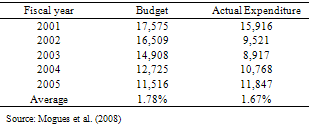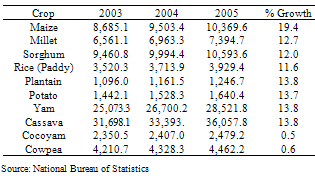-
Paper Information
- Previous Paper
- Paper Submission
-
Journal Information
- About This Journal
- Editorial Board
- Current Issue
- Archive
- Author Guidelines
- Contact Us
International Journal of Agriculture and Forestry
2012; 2(2): 49-55
doi: 10.5923/j.ijaf.20120202.08
Evidence of Climate Change Impacts on Agriculture and Food Security in Nigeria
Bello O. B. 1, Ganiyu O. T. 1, Wahab M. K. A. 1, Afolabi M. S. 2, Oluleye F. 3, Ig S. A. 4, Mahmud J. 5, Azeez M. A. 6, Abdulmaliq S. Y. 7
1Department of Biological Sciences, Fountain University, Osogbo, Osun State, Nigeria
2Department of Crop Science, Landmark University, Omuaran, Kwara State, Nigeria
3Kwara State University, Malete, Ilorin, Kwara State, Nigeria
4Department of Agronomy, University of Ilorin, Ilorin, Nigeria
5Lower Niger River Basin, Ilorin, Kwara State, Nigeria
6Department of Plant Biology, Ladoke Akintola University of Technology, Ogbomoso, Nigeria
7Department of Agronomy, Ibrahim Badamasi Babangida University, Lapai, Niger State, Nigeria
Correspondence to: Bello O. B. , Department of Biological Sciences, Fountain University, Osogbo, Osun State, Nigeria.
| Email: |  |
Copyright © 2012 Scientific & Academic Publishing. All Rights Reserved.
Change in climate and consequent global warming are posing threats to food security in many developing nations including Nigeria because of the climate-dependent nature of agricultural systems and lack of coping capabilities. The spatiotemporal pattern of temperature and rainfall of Nigeria between 1901 and 2005 (105 years), using temperature and rainfall data to support the concept of regional climate change and its impact on Agriculture and food security was investigated. Also assessed was the level of agriculture funding and output in Nigeria. Mean annual air temperature and rainfall data between 1901- 2005 (105 years) were obtained from Food and Agricultural Organization publications, National Bureau of Statistics, Central Bank of Nigeria bulletin and National Meteorological Agency. Descriptive statistics were used to analyze the data. The results showed that within the period of 105 years, rainfall decreased by 81 mm with increasing temperature of 1.1℃. The unpredictability of rainfall and steadily increasing air temperature were observed from 1971-2005. The total federal budget between 2001 and 2005 averaged 824 billion Naira per year of which very small amount (14.7 billion (1.8%)) went to agricultural sector. The actual spending was 681 billion Naira per year with 11.4 billion Naira for agriculture. Over 25 years, there were low and dramatic walloping of public spending in agriculture relative to large size and importance of agricultural sector in the economy. There is a continuous rise in output from 1987 to 2000 before it dropped in 2001. Land degradation, desert encroachment, drying up of surface waters, coastal inundations, and shift in cultivated crops over time affected the food security in Nigeria. The current available data showed that Nigeria, like most parts of the world is experiencing the basic features of climate change. Therefore, Nigerian government/ private sector partnership should encourage agricultural, industrial and domestic practices which will not contribute to the emission of greenhouse gasses.
Keywords: Agricultural Production, Food Security, Climate Change, Rainfall, Temperature, Nigeria
Article Outline
1. Introduction
- Climate change is one of the environmental life- threatening to economic development and sustainability of mankind worldwide. Natural climate cycle and human activities have contributed to an increase in the accumulation of heat-trapping “greenhouse” gases in the atmosphere thereby contributing to increase in temperature in the global climate (global warming) (UNFCCC, 2007). Global warming causes unpredictable and extreme weather events impact and increasingly affect crop growth, availability of soil water, forest fires, soil erosion, droughts, floods, sea level rises with prevalent infection of diseases and pest infestations (Ade juwon, 2004; Zoellick and Robert 2009). These environ mental problems result to low and unpredictable crop yields, which invariably make farmers more vulnerable, especially in Africa (Ziervogel et al., 2006; UNFCCC, 2007). Desertification, uncontrolled grazing, livestock migration, poaching/settlement within protected areas, bushfires and deforestation also posed threats to the environments. All these adversely affected agriculture and food supply, fresh water resources, natural ecosystems, biodiversity and human health, threatening human development and their social, political and economical survival (Zoellick and Robert 2009). The growing problem of climatic change impacts is global and the developing countries, especially Africa will be mostly affected. This is because, African economy is predominantly agrarian rain-fed, fundamentally dependent on the vagaries of weather, due to inability to cope as a result of poverty and low technological development, hence low level of cropping capabilities by the farmers (Ziervogel et al., 2006; Jagtap 2007; Nwafor 2007; Onyenechere 2010). It is projected that crop yield in Africa may fall by 10-20% by 2050 or even up to 50% due to climate change (Jones and Thornton, 2002).Available evidences showed that Nigeria is already being plagued with diverse ecological problems which have been directly linked to the on-going climate change (Adefolalu, 2007; Ikhile, 2007). The southern ecological zone of Nigeria largely known for high rainfall is currently confronted by irregularity in the rainfall pattern, while Guinea savannah experiencing gradually increasing temperature. The Northern zone faces the threat of desert encroachment at a very fast rate per year occasioned by fast reduction in the amount of surface water, flora and fauna resources on land (FME, 2004; Obioha, 2008). This makes people to exploit more previously undisturbed lands leading to depletion of the forest cover and increase on sand dunes/Aeolian deposits in the Northern axis of Nigeria. On the other hand, those in coastal region are vulnerable to incessant floods, destruction of mangrove ecosystems, contamination of water and transmission of water borne diseases, leading to displacement and communal crisis (Odjugo, 2010). The resource poor farmers therefore faced the prospects of tragic crop failures which reduced agricultural productivity, increased hunger, poverty, malnutrition and diseases (Zoellick and Robert 2009; Obioha, 2009). Due to these environmental threats resulting to declining in crop yields, some farmers in Nigeria are abandoning farming for non-farming activities (Apata et al., 2010). Hence, concerted efforts toward tackling these menaces are necessary. The study of the effect of climate change on agricultural productivity is therefore critical, given its impact in changing livelihood patterns in the country. However, for a reasonable conclusion to be drawn on weather data, at least a century of evaluation of climate trend with clear and permanent impacts on the ecosystem is very imperative (Ayoade, 2003; Singer and Avery, 2007). On this premise, there is therefore the need to examine spatiotemporal pattern of temperature and rainfall between 1901and 2005 (105 years), using temperature and rainfall data to support the concept of regional climate change and its impact on Agriculture and food security in Nigeria.
2. Materials and Methods
- The study area is Nigeria. Nigeria is one of the sub- Saharan African nations in the Western part of Africa, and shares land border with the Republic of Benin to the West, Chad and Cameroon to the East, Niger Republic to the North, and its coast lies on the gulf of Guinea (Wikipedia, 2009). The South is defined by its tropical rain forest climate, where annual rainfall is between 60 and 80 inches per year. The North has almost desert-like climate where rainfall is less than 20 inches per year. The rest of the country between the North and the South is savanna, with annual rainfall between 20 and 60 inches per year (Nation Master, 2009). Mean annual rainfall distribution and air temperatures from 1901 to 2005 (105 years) were obtained from 30 Nigerian Meteorological Stations and some States’ Airports. Data of Federal Budget and Actual Expenditure on Agriculture, and Share of Agricultural Sector in Federal Capital Budget were sourced from the Central Bank of Nigeria (CBN) Bulletin. Report of Nigeria House Committee on Agriculture, Trend of Nigeria Agricultural output and Crop Production were collected from National Bureau of Statistics, and Food and Agricultural Organization (FAO) Publications. The time series was used to analyze the trend of rainfall and temperatures. The rainfall pattern was depicted using histogram, while trend lines were used to depict the slope of the rainfall and temperatures. The Share of Agricultural Sector in Federal Capital Budget and the Trend of Nigeria Agricultural output were depicted using the frequency distribution curve.
 | Figure 1. Air temperature distribution in Nigeria between 1901 and 2005 |
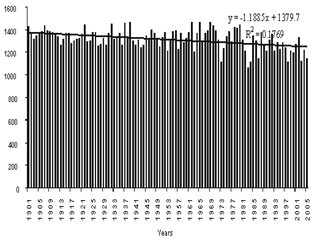 | Figure 2. Rainfall distribution in Nigeria between 1901 and 2005 |
3. Results and Discussion
- Air temperature and rainfall variation impacts in NigeriaIn this study, the trends of air temperature and rainfall distribution in Nigerian were of temporal and spatial in variations as from 1901 to 2005 (Fig. 1 and 2). There is a gradual rise in air temperature between 1901 and mid 1940s with a slight drop from late 1940’s to early 1950s until subsequent increase till late 1960s. However, the evidence of sudden increase in air temperature in Nigeria was observed as from the early 1970s until 2005 ((Fig. 1), This abrupt increase could be linked to the effect of climate change and its associated global warming previously reported in Nigeria by Ikhile, (2007) and supported by the global trend (IPCC, 2007). The mean air temperature from 1901-1970 was 26.3℃ and increased to 27.8℃ from 1971 to 2005. This is apparently greater than the global mean temperature with the increase of 0.74℃ since recordings commenced in 1860 (IPCC, 2007; Spore, 2008). If this trend persists, Nigeria could experience between 1.6℃ and 4.5℃ temperature increase risk by 2100 (Odjugo, 2010). On the other hand, there is a decline in rainfall pattern in Nigeria by 81mm within the period of the study (1901-2005) with a nastiest experience as from early 1970s to date ((Fig. 2). It is worthy to note that the period of drastic rise in temperature from early 1970s corresponds with erratic and decrease in rainfall. However, computed temperature R2=0.8236 (Fig. 1) and rainfall R2= 0.1769 (Fig. 2) within the period of 105 years showed significant increase in temperature in Nigeria, while non significant decrease was recorded for rainfall distribution. All these are strong evidences of climate change impact in Nigeria, because there is incessant increase in rainfall in most coastal areas and drastic decline and erratic in rainfall amount and duration in the continental interiors of the semi-arid region of Nigeria with increasing aridity (Umoh, 2007; Odjugo, 2007, 2009). Recent available evidences of climate change have been reported earlier in Nigeria by (Odjugo, 2009) who observed that the areas experiencing double rainfall maximal (Savannah) is shifting southward, while the short dry season (August Break) is being experienced more in July as against its normal occurrence in the month of August prior to the 1970s. Also, in the North- eastern Nigeria and the Niger-Delta Coastal areas, the number of rain days dropped by 53% and 14% respectively. It has been reported that the erratic rainfall pattern coupled with increasing temperature in Katsina, Maiduguri Kano, Sokoto and Nguru (semi-arid agro-ecological zones of Nigeria) could cause increase in drought evapotranspiration and desertification which resulted to decline in water tables or total dry up of some rivers and lakes especially Lake Chad with continuous extinction of forest and biodiversity (Chindo and Nyelong, 2005; Adefolalu, 2007). Consequently, persistent increase in rainfall in the coaster cities of Lagos, Calabar, Port Harcourt and Warri has resulted to floods in these cities (Ikhile 2007; Nwafor, 2007; Odjugo, 2010). With these factors, one can say with a high level of confidence that this study with other related works cited have successfully revealed that Nigeria, like most parts of the world, is experiencing the basic features of climate change. With all these anomalies, holistic approaches on climate change are required in Nigeria to stem the tide of the erratic rainfall pattern that is currently bedeviling and bothersome since 1970s.
|
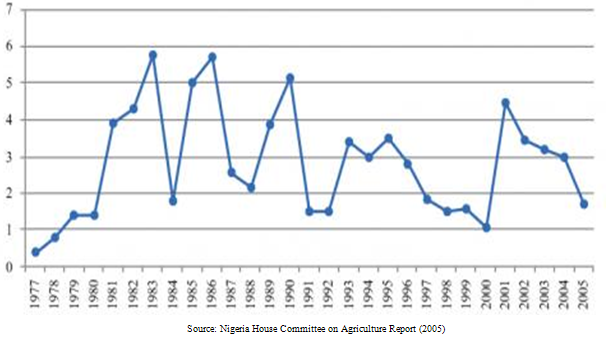 | Figure 3. Share of the Agricultural Sector in Federal Capital Budget (%) 1977-2005 |
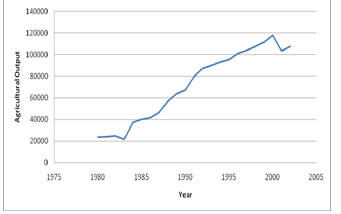 | Figure 4. Trend of Nigeria Agricultural output |
|
4. Conclusions
- Within the 105 years, there is an increase in temperature (1.1℃) and decreasing rainfall amount and duration (81mm) in Nigeria from 1901, but rapidly as from 1970. The air temperature patterns from 1901-1935 and 1936-1971 were almost the same, but differ significantly between 1971 and 2005. The rainfall was unpredictability and decreasing, which also differ significantly from 1971-2005. Coastal region experiencing slightly increasing rainfall since the early 1970s and August break (short-dry-season) is currently being experienced more in July as against August in the Savannah ecology. These evidences show that Nigeria, like most parts of the world, is experiencing the basic features of climate change. However, there is continuous rise in agricultural output from 1987 to 2000 before it dropped in 2001. Low budget allocation to agriculture is not appropriate for a sector that is recognized as the prime driver of growth and poverty reduction in the economy. In Nigeria over 25 years, low and dramatic walloping of public spending in agriculture ensued, relative to large size and importance of agricultural sector in the economy. There is continuous rise in output from 1987 to 2000 before it dropped in 2001. Therefore, Nigerian government/ private sector partnership should focus on improved agricultural productivity by developing technology which will not contribute to changes in climate, but increased production through proper funding and implementation. Provision of new agricultural technologies, afforestation, reduce rate of water pollution and irrigation among others will improve agricultural productivity, enhanced rate of carbon sinks and decline ozone layer depletion, thereby reducing the effects of climate change on humans and ecosystems.
5. Recommendations
- Effective and efficient strategies for climate changeWhile natural causes of climate change cannot be stopped, the effects of climate change can either be stopped or drastically reduced by human. Clean and environment friendly technologies in both energy supply and consumption are prerequisite to reduction in emission of greenhouse gases. In Nigeria, industrial machines and automobiles should be converted to limited or no greenhouse gases emission through the use of ethanol, electric engines or solar engines. Extensive use of low cost solar energy cookers instead of wood burning devices will limit the current pressure on the Nigeria forest for firewood. Gas flaring, oil spillage in the creeks and coastal areas of Nigeria should be drastically reduced to enhance carbon sink in the coastal waters. The use of renewable energy sources such as fuel cells that convert hydrogen fuel directly into electricity without first burning it to produce heat as well as small scale photovoltaic cells should be encouraged. Terrestrial and marine ecosystems that act as carbon sinks and reservoirs to greenhouse gases should be protected and sustained by reducing bush burning and encouraging afforestation. Aluminium, iron and steel should be used for construction of buildings and household furniture in order to reduce deforestation. However, a “Clean Development Mechanisms” that will enable the developed nations to finance emission-avoiding projects in developing countries is required. This will bring credit to the industrialized nations rather than transferring non-environment friendly technologies to developing world like Nigeria. Provision of appropriate economic and regulatory framework for investors and consumers can also improve economy efficiency.Agricultural adaptation to climate changeThe private sectors and Nigeria government should drive the agricultural sector through consistent policies, holistic national adaptation strategy, proper funding and infrastructure development in order to survive the effects of climate change on humans and ecosystems. Better-equipped weather stations to prevent weather-related disasters through early warning and effective response/adaptation system should be established this will help in preventing weather-related disasters through early warning and effective response system. Establishment of disaster mitigation plans in a more formal setting and the upgrading of all systems based on advance in science and technology, with emphasis on space science will enhance knowledge in atmospheric studies for the betterment of man. The on-going plan to supply water to the disappearing Lake Chad from the Congo Basin should be intensified and brought into fruition within the shortest possible time. Transportation of water from the Atlantic Ocean to the Lake Chad through pipelines after desalination should be looked into. Such water transfer will definitely increase the volume and also the area coverage of the Lake. This means more water for irrigation farming, fishing, domestic and industrial usage. Readily available farming inputs (inorganic fertilizers, improve seeds and chemicals) and subsidies should be entrenched. Credit facility, extension services, effective processing and storage technologies and market systems should be provided to farmers. Education, information and training of farmers to adapt to climate change by changing their farming practices such as bush burning, deforestation, rain-fed agriculture and land tenure systems should be encouraged. Agricultural research (funding and activities) should be decentralized by making them participatory to increase adoption of innovations and encouraged increase in agricultural production. There should be integration of indigenous knowledge and practices into formal climate change mitigation and adaptation strategies. With the decreasing rainfall amount and duration, frequent drought and desertification, drought resistant and short duration high yielding crops should be developed and made available to farmers. Improved animal husbandry including improved brood stock traits, health and feeds should be provided to farmers. Encouragement of formation of farmer groups, and agricultural adaptation to climate change should be mainstreamed into government’s poverty alleviation programme. Other stakeholders should invest in improved agricultural technology to be able to cope with climate change. Nigeria should start to invest on irrigation farming rather than relying more on rain-fed agriculture that is highly unreliable and becoming more unpredictable. The problems of climate change are already with us, therefore these constraints should be properly addressed for self sufficiency in food production and for export, thereby enhancing virile economy.
 Abstract
Abstract Reference
Reference Full-Text PDF
Full-Text PDF Full-Text HTML
Full-Text HTML